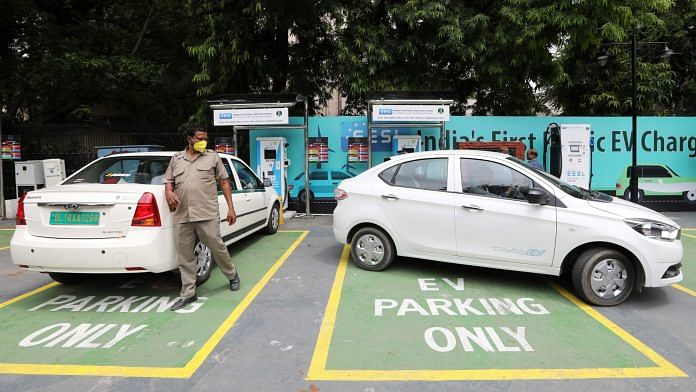New Delhi: Two-wheelers, three-wheelers and four-wheelers (especially light goods transport) electric vehicles could be able to swap depleted batteries with charged ones by the middle of next year, senior government officials told ThePrint.
Finance minister Nirmala Sitharaman had announced the formulation of an ambitious battery swapping policy in the Union Budget 2022-23 on 1 February. The Narendra Modi government is pushing for faster adaption of electric vehicles, and has set a 2030 target for electrifying all new vehicles.
“The battery swapping policy being prepared by NITI Aayog will be in place by the end of this year and we are hopeful that by mid-next year, we can see the system take off. By next year, the entire ecosystem will start flourishing,” Sudhendu Jyoti Sinha, adviser (Infrastructure Connectivity—Transport and Electric Mobility), NITI Aayog, told ThePrint.
Sinha and other government officials pointed out that the pace of adoption of electric vehicles across categories, especially in two-wheelers, has seen a steep rise. “Last year, around March-April, we had supported 35,000 two-wheeler electric vehicles out of the target of 10 lakh vehicles. So, it was 3.5 per cent. Today, the number has risen from 35,000 in 8-9 months to 2.30 lakh vehicles. You wait for another 8 months. It will rise to 7-8 lakh. The rise is very steep,” he added.
Also read: Two-minute battery changes push India’s delivery riders to switch to e-scooters
Ease and affordability
Initially, battery swapping facilities will be available within city limits only, but will expand gradually to one swapping station after every 50 km on the highway.
Apart from making customers’ lives easier, the move is also expected to bring down the upfront cost of electric vehicles. For an electric car that costs Rs 15 lakh, the cost of the battery is approximately Rs 6 lakh. If that amount is taken away, then a vehicle’s cost comes down to around Rs 9 lakh.
“Electric vehicles will become affordable because customers will not be purchasing the battery. They can take a battery on lease and swap it at battery swapping stations,” Sinha added.
The swapping policy being drafted by the NITI Aayog will address issues like, who can operate a swapping station, where these stations will be set up, and the cost of swapping batteries and charging.
“The principal idea is affordability. We will come up with pricing in a couple of months after discussing it with stakeholders”, Sinha said.
The policy will also look into the kind of financial incentives and models that can be worked out for those setting up swapping stations. Officials preparing the draft policy said they are also discussing how the swapping stations will work.
One of the officials said, that these stations could be like an alcove kept at a convenient point, with specific rectangular spaces, where batteries are kept with infrastructure to charge them. “The moment you come with your vehicle, the battery will be taken out and a charged one will be put inside,” one of the officials said.
Sinha added, “My understanding is as of now all vehicles are accustomed to petrol fill stations. If we can develop swapping booths at the existing filling station, nothing like it.”
The government also expects private investments to come forward for setting up battery swapping stations.
Another key aspect being looked into by the NITI Aayog is what happens to the batteries when their life cycle comes to an end. “We have to come up with proper battery waste management rules. Otherwise, the solution to the problem with sustainability will start creating a bigger problem for sustainability, the way plastic has done,” the unnamed official quoted above said.
Work on battery swapping standards
While the NITI Aayog is coordinating with different ministries including heavy industries and road transport to prepare the battery swapping policy, the Bureau of Indian Standards (BIS) is readying the standard for battery swapping.
Four technical teams have been set up by the BIS for preparing the prototype standards that will be put to test before being finalised.
A BIS official, who did not want to be named, said that as far as battery swapping is concerned, there are two dimensions. One is the policy, second is standards.
In the standard, there are four areas that are being considered, the official said. First, is the physical format of the battery, that is, length, breadth, weight, etc. The second is that of connectors. The third is what will be the communication protocol between the battery and the vehicle or the charging station. Last is the issue concerning interoperability.
“The idea of a standard is to have uniformity for proliferation, for safety and also ease,” the BIS official said.
An important aspect that the technical teams are looking at is the size of the batteries. “The battery mass is very critical. The customer should be able to lift the depleted battery from the vehicle and put the charged one back in the vehicle. It should not be more than 10 kg so that an 18-year-old or 60-year-old can lift it,” the official said.
According to officials, the standard that is being considered will be similar to international standards.
Officials said that typically, the weight of an electric vehicle should be light. “The vehicle structure should be light, otherwise it will become very unwieldy,” one of the officials said.
Ensuring that safety standards are followed will be very critical to the whole battery swapping ecosystem.
The existing vehicles, the official said, can be retrofitted. “Some of the states are going for retro fitment in the same way they had done in case of CNG. But from the central government’s side, incentives are not there for retro fitment. States can go ahead with it and I don’t think there is anything wrong in it other than of course you have to maintain the safety standards,” an official said.
(Edited by Manoj Ramachandran)
Also read: E-vehicle charging stations every 40-60 km, 40,000 km of highway coverage: NHAI’s 2023 target






